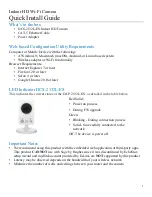
6
3 Service Navigation
3.1.
Introduction
This service manual contains technical information, which allow service personnel’s to understand and service this model.
Please place orders using the parts list and not the drawing reference numbers.
If the circuit is changed or modified, the information will be followed by service manual to be controlled with original service manual.
3.2.
General Description About Lead Free Solder (PbF)
The lead free solder has been used in the mounting process of all electrical components on the printed circuit boards used for this
equipment in considering the globally environmental conservation.
The normal solder is the alloy of tin (Sn) and lead (Pb). On the other hand, the lead free solder is the alloy mainly consists of tin
(Sn), silver (Ag) and copper (Cu), and the melting point of the lead free solder is higher approx.30°C (86°F) more than that of the
normal solder.
Distinction of P.C.B. Lead Free Solder being used
Service caution for repair work using Lead Free Solder (PbF)
• The lead free solder has to be used when repairing the equipment for which the lead free solder is used.
(Definition: The letter of “PbF” is printed on the P.C.B. using the lead free solder.)
• To put lead free solder, it should be well molten and mixed with the original lead free solder.
• Remove the remaining lead free solder on the P.C.B. cleanly for soldering of the new IC.
• Since the melting point of the lead free solder is higher than that of the normal lead solder, it takes the longer time to melt the
lead free solder.
• Use the soldering iron (more than 70W) equipped with the temperature control after setting the temperature at 350±30°C
(662±86°F).
Recommended Lead Free Solder (Service Parts Route.)
• The following 3 types of lead free solder are available through the service parts route.
SVKZ000001-----------(0.3mm 100g Reel)
SVKZ000002-----------(0.6mm 100g Reel)
SVKZ000003-----------(1.0mm 100g Reel)
Note
* Ingredient: Tin (Sn) 96.5%, Silver (Ag) 3.0%, Copper (Cu) 0.5%. (Flux cored)
Summary of Contents for HC-VXF990EB
Page 10: ...10 ...
Page 11: ...11 ...
Page 13: ...13 ...
Page 14: ...14 ...
Page 15: ...15 ...
Page 25: ...25 8 2 PCB Location ...
Page 28: ...28 8 3 1 Removal of the Side Case L Unit Fig D1 Fig D2 ...
Page 29: ...29 Fig D3 Fig D4 ...
Page 30: ...30 8 3 2 Removal of the Wi Fi P C B Fig D5 8 3 3 Removal of the Front Case Unit Fig D6 Fig D7 ...
Page 32: ...32 Fig D10 8 3 6 Removal of the Wi Fi Frame Unit Barrier Motor Unit Lens Frame Unit Fig D11 ...
Page 33: ...33 Fig D12 8 3 7 Removal of the Camera Lens Unit Fig D13 ...
Page 35: ...35 8 3 10 Removal of the Jack DC Gyro P C B Fig D16 8 3 11 Removal of the Main P C B Fig D17 ...
Page 37: ...37 Fig D21 8 3 14 Removal of the SD Door Unit LCD Unit Fig D22 ...
Page 39: ...39 Fig D25 8 3 17 HC VXF990 VXF999 Removal of the LCD Hinge Unit Fig D26 ...
Page 40: ...40 Fig D27 8 3 18 Removal of the Monitor P C B LGP Unit LCD Fig D28 ...
Page 41: ...41 Fig D29 8 3 19 Removal of the Mic P C B Fig D30 ...
Page 42: ...42 8 3 20 Removal of the Front Base Barrier R Barrier F Photo Light P C B Fig D31 Fig D32 ...
Page 44: ...44 Fig D35 8 3 23 Removal of the Kurupon Unit Front P C B Fig D36 ...
Page 49: ...49 Level Shot Adjutment Chart ...
Page 51: ...51 9 1 2 Adjustment Items Adjustment item as follows ...
Page 54: ...54 ...
Page 55: ...55 ...
Page 56: ...56 ...
Page 57: ...57 ...
Page 58: ...58 ...
Page 59: ...59 ...
Page 60: ...60 ...







































